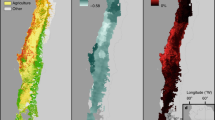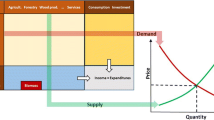Abstract
An empirical investigation is undertaken into the impact of the Structural Adjustment Programme (SAP) on forest and biodiversity loss in Ghana between the period 1965–1995. In the first part of the analysis, a four-equation recursive model, consisting of forest loss, cocoa land, maize land and timber production equations, is employed to examine the impact of the SAP on forest loss. The first equation is a function of the last three, and the last three are functions of mainly prices. Piecewise linear and switching regression approaches are used to distinguish between the influence of the post from the pre-adjustment impacts. These results together with a specie-forest area relationship are used to investigate the impact of the SAP on biodiversity loss. The overall results indicate that cocoa land expansion and timber production, but not maize land expansion, are the significant causes of forest loss in Ghana. However, the impact on forest loss in the post-adjustment period was reduced. The rate of biodiversity loss also reduced in the post-adjustment period. Changes in relative output and input prices due to the SAP may have played a significant role in the reduced impact of agricultural and timber related deforestation and biodiversity loss in the post-adjustment period.
Similar content being viewed by others
References
Abbiw, D. K. (1989), 'Non-wood Forest Products (minor forest products)’ Ghana Forest Inventory Project Seminar Proceedings, 79-88. Accra: Ghana Forestry Department.
Alexandre, D. Y. (1978), 'Le rôle Disseminateur des éléphants en forêt de Taï, Côte d'Ivoire', La Terre et la Vie 32, 47-72.
Amelung, T. and M. Diehl (1992), 'Deforestation of Tropical Rainforests: Economic Causes and Impact on Development'. Kieler Studien 241. Tubingen: J.C.B. Mohr.
Barbier, E. B. (1994), 'The Environmental Effect of the Forestry Sector’ in The Environmental Effects of Trade. Paris: Organization of Economic Cooperation and Development (OECD).
Barbier, E. B. and J. C. Burgess (1997), 'The Economics of Tropical Forest Land Use Options’ Land Economics 73(2), 174-195.
Barbier, E. B., J. C. Burgess and C. Folke (1995), Paradise Lost? The Ecological Economics of Biodiversity. London: Earthscan.
Bateman, M. J. et al. (1989), An Analytical Review of Ghana's Cocoa Pricing Policy with Recommendation for Future Policy Formulation, A Report Prepared for the World Bank. Washington, DC: World Bank.
Benhin, J. K. A. and E. B. Barbier (2001), 'The Effects of the Structural Adjustment Program on Deforestation in Ghana'. Agricultural and Resource Economics Review (forthcoming).
Benhin, J. K. A. and E. B. Barbier (1999a), Structural Adjustment Programme, Deforestation and Biodiversity Loss in Ghana, A Paper Presented at the Ninth Annual Congress of the European Association of Environmental and Resource Economists (EAERE), Oslo, 25-27 June.
Benhin, J. K. A. and E. B. Barbier (1999b), A Comparative Analysis of the Effects of Structural Adjustment on Agriculture and on Forest Cover in Cameroon and in Ghana, Final Report Prepared for the Center for International Forestry Research (CIFOR), Bogor, unpublished.
Brown, K. and D. Pearce, eds. (1994), The Causes of Tropical Deforestation. London: University College London Press.
Burgess, P. F. (1971), 'The Effects of Logging on Hill Depterocarp Forest’ Malaysia Nature Journal 24, 231-237.
Capistrano, A. D. (1994), 'Tropical Forest Depletion and the Changing Macroeconomy, 1967-1985’ in K. Brown and D. W. Pearce, eds., The Causes of Tropical Deforestation (pp. 68-85). London: University College London Press.
Chachu, R. (1989), 'Allowable Cut from the Forest’ in J. Wong, ed., Ghana Forest Inventory Project Seminar Proceedings 29-30 March 1989. Accra: Ghana Forestry Department and ODA.
Connor, E. F. and E. D. McCoy (1979), 'The Statistics and Biology of Species-area Relationship’ American Naturalist 13, 791-833.
Cropper, M. and C. Griffiths (1994), 'The Interaction of Population Growth and Environmental Quality’ American Economic Review 84(2), 250-254.
Deacon, R. T. (1995), 'Assessing the Relationship between Government Policy and Deforestation’ Journal of Environmental Economics and Management 28, 1-8.
Ehui, S. K. and T.W. Hertel (1989). 'Deforestation and Agricultural roductivity in the Côte d'Ivoire’ American Journal of Agricultural Economics 71(3), 703-711.
FAO (1999), FAOSTATS Database, CD-ROM. Rome: FAO.
FAO (1997), State of the World's Forests 1997. Rome: FAO.
Friends of the Earth (1992), Plunder of Ghana's Rainforest for Illegal Profit, Vol. 2: Research Report. London: Friends of the Earth.
Gartlan, S. (1990), Practical Constraints on Sustainable Logging in Cameroon, Paper Presented at the Abidjan Conference on Forest Conservation in West and Central Africa, November.
Glowka, L., F. Burhenne-Guilmin, H. Synge, J. McNeely and L. Gündling (1994), 'A Guide to the Convention on Biological Diversity’ Environmental and Policy Paper No. 30. IUCN.
Gujarati, D. N. (1995), Basic Econometrics, 3rd ed. New York: McGraw-Hill, Inc.
Hawthorne, W. D. (1989), 'The Flora and Vegetation of Ghana's Forests’ in Ghana Forestry Inventory Project Seminar Proceedings, 8-14. Accra: Forestry Department.
ICBP/IUCN (1985), Threatened Birds of Africa and Related Islands: The ICBP/IUCN Red Data Book, Part 1. Cambridge: ICBP/IUCN.
ISSER (1992), The State of the Ghanaian Economy in 1991. Accra: ISSER, University of Ghana.
ISSER (1996), The State of the Ghanaian Economy in 1995. Accra: ISSER, University of Ghana.
ITTO (1993), Study of Incentives for the Sustainable Management of the Tropical High Forest of Ghana, A Report Prepared by IIED and the Forestry Department Of Ghana, unpublished.
IUCN (1988), Ghana, Conservation of Biological Diversity. Briefing Paper Prepared by the International Union for the Conservation of Nature and Natural Resources, Tropical Forest Programme, Cambridge.
Kaimowitz, D. and A. Angelsen (1997), A Users Guide to Economic Models of Deforestation. Bogor: Center for International Forestry Research (CIFOR).
Kingdon, J. (1990), Island Africa: The Evolution of Africa's Rare Animals and Plants. London: Collins.
López, R. (1997), 'Environmental Externalities in Traditional Agriculture and the Impact of Trade Liberalization: The Case of Ghana’ Journal of Development Economics 53, 17-39.
Lugo, A. E., J. A. Parrotta and S. Brown (1993), 'Loss of Species Caused by Tropical Deforestation and their Recovery through Management’ AMBIO 22(2-3), 106-109.
Manu, M. and E. K. Tetteh (1987), A Guide to Cocoa Cultivation. Accra: Cocoa Research Institute of Ghana, Ghana Cocoa Board.
Martin, C. (1991), The Rainforests of West Africa: Ecology. Accra: Elsevier Publishers.
Mensah-Ntiamoa, A. Y. (1989), Pre-feasibility Study of Wildlife Potentials in the Kakum and Asin-Attandoso Forest Feserves-Central Region-Ghana. Accra: Department of Game and Wildlife, unpublished.
Ministry of Agriculture (1991), Agriculture in Ghana: Facts and Figures. Accra: Policy Planning, Monitoring and Evaluation Department (PPMED), Ministry of Agriculture.
Munasinghe, M. (1999), 'Introduction: Special Topic 1-Structural Adjustment Policies and the Environment’ Environment and Development Economics 4, 9-18.
Munasinghe, M. (1996), 'An Overview of the Environmental Impacts of Macroeconomic and Sectoral Policies’ in M. Munasinghe, ed., Environmental Impacts of Macroeconomic and Sectoral Policies (pp. 1-14). Washington, DC: World Bank.
Myers, N. (1989), Deforestation Rates in Tropical Forests and their Climatic Implications. London: Friends of the Earth.
Oldfield, S. (1991), Pre-project Study on the Conservation Status of Tropical Timbers in Trade. Final Report Prepared for the International Tropical Timber Organization by the World Conservation Monitoring Centre, February 1991, Cambridge.
Olsen, D. K. and S. Curtin (1984), 'The Role of Economic Timber Specie in the Ecology of Black and White Colobus and Dana Monkeys in Bia National Park, Ghana’ International Journal of Primatology.
Perrings, C. (2000), 'The Biodiversity Convention and Biodiversity Loss in Sub-Saharan Africa’ in C. Perrings, ed., The Economics of Biodiversity Conservation in Sub-Saharan Africa: Mending the Ark. Cheltenham: Edward Elgar.
Pindyck, R. S. and D. L. Rubinfeld (1991), Econometric Models and Economic Forecasts. NewYork: McGraw-Hill, Inc.
Reed, D. (1996), Structural Adjustment, the Environment, and Sustainable Development. London: Earthscan.
Reid, W. V. (1992), 'How Many Species Will There Be?’ in T. C. Whitmore and J. A. Sayer, eds., Tropical Deforestation and Species Extinction. London: Chapman and Hall.
Repetto, R. (1988), The Forests for the Trees? Government Policies and the Misuse of Forest Resources. Washington, DC: World Resources Institute (WRI).
Richards, M. (1995), Role of Demand Side Incentives in Fine Grained Protection: A Case Study of Ghana's Tropical High Forests. London: ODA.
Rudel, T. and J. Roper (1997), 'The Paths to Rain Forest Destruction: Crossnational Patterns of Tropical Deforestation, 1975-1990'. World Development 25(1), 53-65.
Sankhayan, P. L. (1996), 'Effects of Structural Adjustment Programmes on Cropping Pattern and Environment: A Study in the Southern Highlands of Tanzania’ in Structural Adjustment Policies and Environmental Degradation in Tanzania, Zambia and Ethiopia, Preliminary Seminar Report, 9-10 January. Agricultural University of Norway.
Sayer, J. A., C. S. Harcourt and N. M. Collins (1992), The Conservation Atlas of Tropical Forests: Africa. London: Macmillan Pub.
Simberloff, D. (1986), 'Are We on a Verge of a Mass Extinction in Tropical Rain Forests?’ in D. K. Elliot, ed., Dynamics of Extinction. New York: John Wiley.
Southgate, D., R. Sierra and L. Brown (1991), 'The Causes of Tropical Deforestation in Ecuador, A Statistical Analysis’ World Development 19(9), 1145-1151.
Struhsaker, T. T. and J. F. Oates (1975), 'Comparison of the Behaviour and Ecology of Red Colobus and the Black and White Colobus Monkeys in Uganda’ in Socio-ecology and Psychology of Primates. The Hague.
Sun, C. (1995), Tropical Deforestation and the Economics of Timber Concession Design. Department of Agricultural Economics, University of Illinois at Urbana-Champaign, Urbana, Doctoral Dissertation Proposal.
UNEP (1995), Global Biodiversity Assessment. London: Cambridge University Press.
Wong, J. (1989), Ghana Forest Inventory Project Seminar Proceedings, 29-30 March 1989. Accra: Ghana Forestry Department and the ODA.
World Bank (1989), World Development Report 1989. Oxford: Oxford University Press.
World Conservation Monitoring Centre (WCMC) (1992), Global Biodiversity: Status of the Earth's Living Resources. London: Chapman and Hall.
World Resources Institute (WRI) (1994), World Resources 1994-1995: People and the Environment. Oxford: Oxford University Press.
Author information
Authors and Affiliations
Rights and permissions
About this article
Cite this article
Benhin, J.K., Barbier, E.B. Structural Adjustment Programme, Deforestation and Biodiversity Loss in Ghana. Environmental and Resource Economics 27, 337–366 (2004). https://doi.org/10.1023/B:EARE.0000017653.15107.0f
Issue Date:
DOI: https://doi.org/10.1023/B:EARE.0000017653.15107.0f




